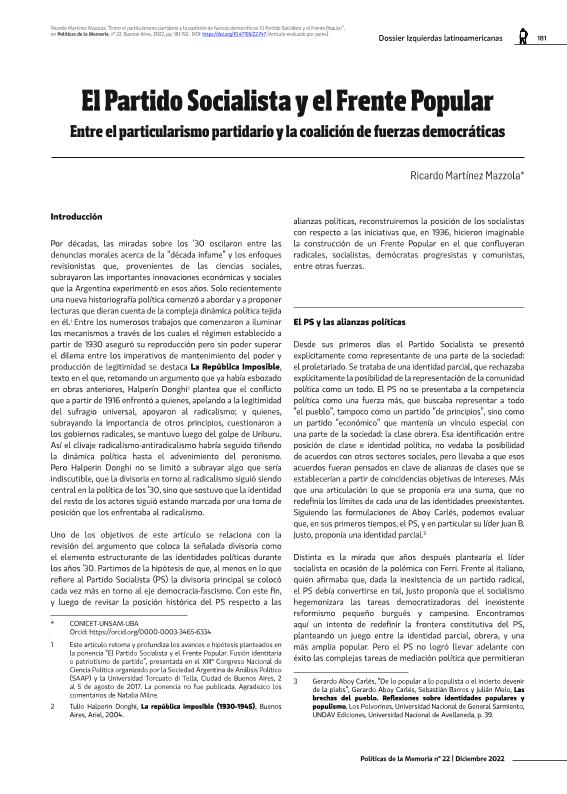Artículo
En la década del ‘30 el Partido Socialista (PS) experimenta importantes cambios. Dejando de lado la postura de orgullosa soledad de sus años fundacionales, mantenida incluso luego de que la Ley Sáenz Peña lo colocara en lugares de responsabilidad política, avanza por primera vez hacia alianzas con otras fuerzas. A la Alianza Civil, entablada junto al Partido Demócrata Progresista (PDP) en 1931 siguen los, más ambiciosos intentos de 1936, orientados a conformar un Frente Popular que reuniría al PS no solo con el PDP, y con sus hermanos-enemigos del Partido Comunista, sino también con la Unión Cívica Radical, una fuerza con la que tenía una larga historia de desconfianzas y la que, por su indiscutible peso político, ocuparía un lugar predominante en la coalición. En este artículo reconstruiremos las posiciones que el PS adoptó frente a la perspectiva de una posible integración en el Frente Popular. En las reflexiones finales partiremos de la distinción de tres dimensiones presentes en toda identidad política propuesta por Gerardo Aboy Carlés, para señalar los elementos que hacían posible la confluencia identitaria y también para dar cuenta de los límites que la identidad fijó a la adhesión a la propuesta de Frente Popular. In the 1930s the Partido Socialista (PS) underwent important changes. Leaving aside the position of proud loneliness of its founding years, maintained even after the Sáenz Peña Law placed it in places of political responsibility, it is advancing for the first time towards alliances with other forces. The Alianza Civil, established together with the Partido Demócrata Progresista (PDP) in 1931, is followed by the more ambitious attempts of 1936, aimed at forming a Popular Front that would unite the PS not only with the PDP, and with its brother-enemies of the Partido Comunista, but also with the Unión Cívica Radical, a force with which it had a long history of mistrust and which also, due to its indisputable political weight, would occupy a predominant place in the coalition. In this article we will reconstruct the positions that the PS adopted in light of the prospect of possible integration into the Popular Front. In the final reflections we will start from the distinction of three dimensions present in all political identity proposed by Gerardo Aboy Carlés, to point out the elements that made identity confluence possible and also to account for the limits that identity set to adherence to the Popular Front proposal.
Entre el particularismo partidario y la coalición de fuerzas democráticas: El Partido Socialista y el Frente Popular
Título:
Between partisan particularism and the coalition of democratic forces: The Partido Socialista and the Popular Front
Fecha de publicación:
10/2022
Editorial:
Centro de Documentación e Investigación de la Cultura de Izquierdas
Revista:
Políticas de la Memoria
ISSN:
1668-4885
e-ISSN:
2683-7234
Idioma:
Español
Tipo de recurso:
Artículo publicado
Clasificación temática:
Resumen
Palabras clave:
SOCIALISMO
,
FRENTE POPULAR
,
ALIANZAS POLÍTICAS
,
IDENTIDADES
Archivos asociados
Licencia
Identificadores
Colecciones
Articulos(SEDE CENTRAL)
Articulos de SEDE CENTRAL
Articulos de SEDE CENTRAL
Citación
Martinez Mazzola, Ricardo Hernan; Entre el particularismo partidario y la coalición de fuerzas democráticas: El Partido Socialista y el Frente Popular; Centro de Documentación e Investigación de la Cultura de Izquierdas; Políticas de la Memoria; 22; 10-2022; 181-192
Compartir
Altmétricas




